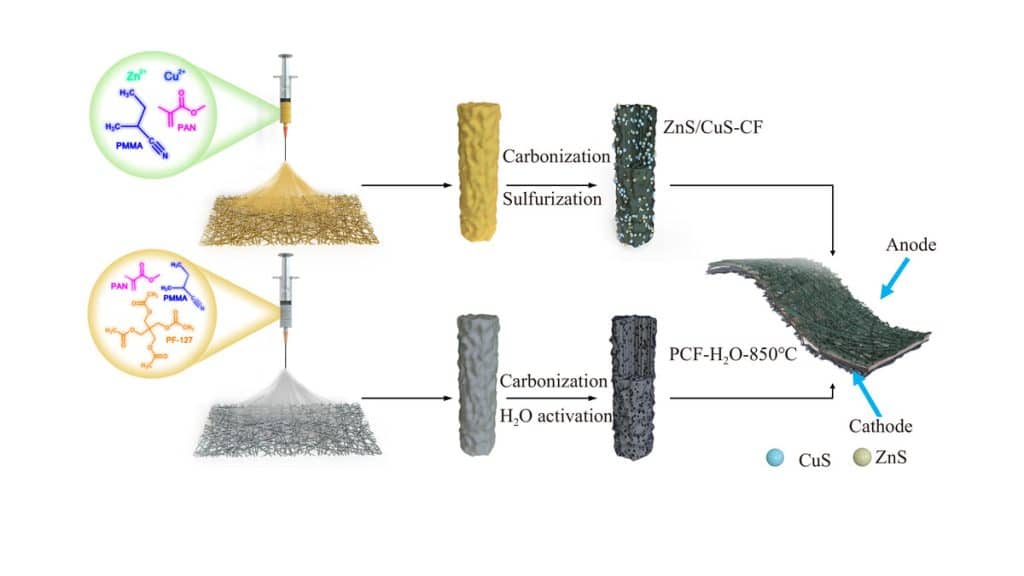Researchers from Tsinghua University created zinc-sulfide nanoparticles that can be incorporated into multichannel carbon fibers (CFs) to improve performance of Li-Ion supercapacitors performance. The results were published in Energy Materials and Devices journal.
Transition metal sulfides (TMSs) are widely recognized for their potential as anode materials in the development of flexible lithium-ion capacitors (FLICs) owing to their high theoretical capacity. However, their practical application has been significantly limited by rapid capacity decay and sluggish kinetics associated with TMS volume variation. In response to these challenges, we have prepared ZnS/CuS nanoparticles embedded in continuous and multichannel carbon fibers (CFs).
This was achieved through a process involving blow-spinning and subsequent sulfidation. Notably, the electrochemical performance of these materials was largely improved, owing to the synergistic effect of bimetallic sulfides. The ZnS/CuS-CF anode material demonstrated a high specific capacity of over 900 mAh g−1 at a current density of 0.2 A g−1. Furthermore, it exhibited superior rate capacity (300 mAh g−1 at 20 A g−1) and excellent cyclic stability, maintaining its performance over 1000 cycles at 10 A g−1. We also prepared lithium-ion capacitors (LICs) using the same method.
These LICs exhibited a maximum energy density of 136 Wh kg−1, a high power density of 43.5 kW kg−1, and an impressive cyclic stability over 4000 cycles. In addition, the FLICs, when configured in the form of a pouch cell, demonstrated significant potential for the development of smart, flexible electronic devices.
“An effective strategy to enhance the energy and power densities of CF-based anode materials involves coupling them with highly active materials.” said Bohan Li, Researcher and Author, Tsinghua University Press.
Multichannel carbon fibers with embedded ZnS/CuS nanoparticles are the end product. This material demonstrated enhanced high specific capacity and rate capacity, along with decreased resistance to charge transfer and ion diffusion. Improvements in energy and power densities were achieved by combining mixed metal sulfides with a FLIC.
Combining metals like zinc with sulfides and carbon fibers seems to be a successful way to create a high-capacity anode. The metals can react more quickly due to the high activity level, a major improvement over FLICs.
The carbon fiber network’s structure not only enhances the material’s performance but also lessens the possibility of nanoparticles bunching up, preserving stability and cycle consistency.
“Carbon fibers function as a conductive network and 3D matrix, accommodating volume expansion and maximizing the high-capacity feature of ZnS and CuS nanoparticles. This enhances the specific capacity and cycle stability of CF-based anode materials.” Add Bohan Li
The three-dimensional matrix of the carbon fibers also limits the expansion of ZnS and CuS. At best, an expansion of the battery’s internal components may result in a reduction in performance, and at worst, the battery may completely fail.
A pouch cell was used to test the technology’s usability under pressure (bending). Pouch cells, which are frequently found in laptops, cell phones, and cars, are essentially an enclosed anode and cathode with a separator and conducting material.
The outcomes demonstrate the technology’s versatility, as an LED was successfully lit up at all angles when bent at different angles. The technology not only resisted initial bending, but it also effortlessly assumed its original shape – a crucial feature of flexible technology.
The material intends to advance current technology to increase the range of intelligent, adaptable gadgets that are becoming more and more popular. Advances in these electronics may result in more environmentally friendly technology accessible to both businesses and consumers.
For ZnS/CuS nanoparticle production on a continuous carbon fiber network to be a technology that can be utilized in wearable and portable devices instead of the standard TMSs used in FLICs, it would need to be scaled up.
Reference link:
Li, B., et al. (2024) ZnS/CuS nanoparticles encapsulated in multichannel carbon fibers as high-performance anode materials for flexible Li-ion capacitors.
SciOpen. doi.org/10.26599/EMD.2023.9370012
